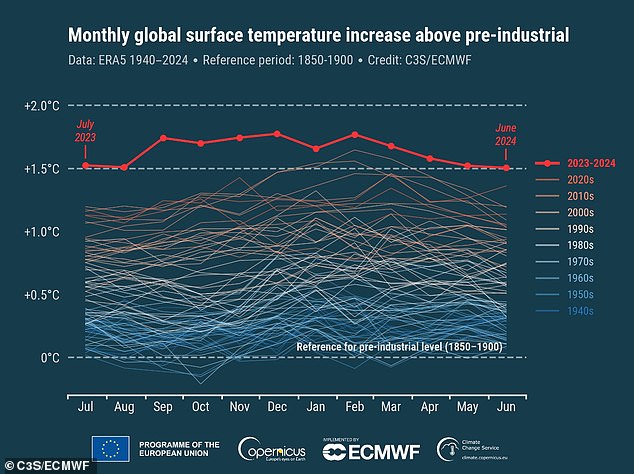Last month was officially the hottest June on RECORD – marking the 13th consecutive month of record-breaking temperatures, figures reveal
In Britain, June was a ‘month of contrasts’ with drizzle and a late heatwave.
Globally, the Earth experienced its warmest June on record, scientists from the EU Climate Change Programme reported.
Last month was not only the warmest month of the year so far, but also the 13th consecutive record month.
In other words, every month since June 2023 has been the warmest ever recorded for that specific month – indicating a continued warming trend.
Experts blame greenhouse gas emissions and warn of an ongoing “climate disaster.”
June 2024 was the warmest June on record globally, with an average surface temperature of 61.98°F (16.66°C). This map shows where the Earth experienced extreme heat last month, compared to the 1991-2020 reference period

Globally, June 2024 was the warmest June since at least 1940, when the EU department began keeping records. People pictured cool off at Coney Island on a balmy afternoon on the first day of summer on June 20, 2024 in New York City
According to the EU Copernicus Climate change Service (C3S), the The average global temperature for June 2024 was 61.98°F (16.66°C).
This is 0.25°F (0.14°C) above the temperature of the previous warmest month June – June 2023.
Worryingly, this is also 1.2°F (0.67°C) warmer than the global average for June during 1991-2020.
“June marks the 13th consecutive month with record temperatures on Earth, and the 12th in a row with temperatures above 1.5°C above pre-industrial levels,” said Carlo Buontempo, director of C3S.
‘This is more than a statistical oddity; it highlights a major and ongoing change in our climate.
‘Even if this particular series of extremes ends at some point, we will undoubtedly see new records broken as the climate continues to warm.
“This is inevitable unless we stop emitting greenhouse gases into the atmosphere and oceans.”

According to C3S, the temperature in June 2024 was 2.7°F (1.5°C) above the estimated June average for 1850–1900, the designated pre-industrial reference period.

People seek shelter from the sun with an umbrella as they stand still in Sultanahmet Square, one of the city’s most famous tourist attractions, in Istanbul, Turkey, June 28, 2024

June marks the 13th consecutive month of record-breaking global temperatures. Here, a woman cools off in a fountain in Moscow, Russia, June 30, 2024
C3S, managed by the European Commission, tracks temperature measurements from a variety of platforms and instruments, from weather stations to weather balloons and satellites.
The department’s measurements refer to the average air temperature for the entire planet over the entire year, which is lower than a single, usually ‘warm’ temperature measurement.
According to C3S, the temperature in June 2024 was 2.7°F (1.5°C) above the estimated June average for 1850–1900, the designated pre-industrial reference period.
In addition, the global average temperature over the past 12 months (July 2023 to June 2024) is now the highest ever recorded.
Over the past 12 months, temperatures were 1.36°F (0.76°C) above the average between 1991 and 2020 and 2.95°F (1.64°C) above the pre-industrial average from 1850 to 1900, the ministry said.

A man cools down as he stands in front of ‘water sprinklers’ placed along the side of the road as temperatures rise in the capital Baghdad on June 30, 2024

Long periods of hot, dry weather and a lack of rain make forest fires more likely. Pictured, a firefighting helicopter drops water as a forest fire rages in Stamata, near Athens, Greece, June 30, 2024
When looking at Europe separately from the rest of the world, temperatures last month were 2.82°F (1.57°C) above the 1991-2020 average for June, making it the second warmest June on record for Europe.
Temperatures in Europe were most above average in the southeastern regions and Turkey, but around or below average in Western Europe, Iceland and northwestern Russia.
Outside Europe, temperatures were highest in eastern Canada, the western US and Mexico, Brazil, northern Siberia, the Middle East, North Africa and West Antarctica.
CS3 also revealed that the average sea surface temperature (another measure of warmth close to the sea surface) was 20.85°C last month, the highest value ever recorded for the month of June.
This is the fifteenth consecutive month that the sea surface temperature has been the warmest in the data set for the respective month of the year.
In response to the new record for June, environmental group Greenpeace said “polluters must pay the ever-increasing bill” for extreme weather.
The finger is being pointed at the fossil fuel industry, which emits greenhouse gases such as CO2 and methane through the combustion of fossil fuels such as coal, gas and oil.
“The fossil fuel industry is causing widespread and irreversible losses and damage by continuing its operations while ignoring the climate impacts,” said Avinash Kumar Chanchal of Greenpeace South Asia.
‘Our communities are already experiencing the worst impacts of heatwaves, including health risks, deaths and livelihood crises, especially among the most vulnerable,
‘Marginalized groups, including women, children, the elderly, poor communities, workers and people who work outside the home, suffer the most.
‘These people often don’t have the money or resources to deal with such a climate disaster.’
Looking specifically at the UK, Britons saw “below average” temperatures in June despite a late heatwave, the Met Office said last week.
In the UK in particular, June was a ‘month of contrasts’ for many. The first half of the month was cool, but later in the month it was warmer. There was also relatively little rain, especially in the south.
